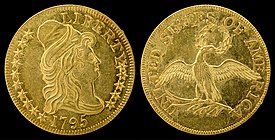This article includes a list of references, related reading, or external links, but its sources remain unclear because it lacks inline citations. (March 2024) |
United States | |
| Value | 5 U.S. dollars (face value) |
|---|---|
| Edge | Reeded? |
| Composition | 91.67% Au, 3% Ag, 5.33% Cu |
| Years of minting | 1795–1929 (circulating) 1983–present (bullion coin) |
| Obverse | |
 | |
| Design | Classic Head |
| Designer | William Kneass |
| Design date | ? |
| Design used | 1834–1839 |
| Reverse | |
 | |
| Design | ? |
| Designer | ? |
| Design date | ? |
| Design used | ? |
The half eagle is a United States coin that was produced for circulation from 1795 to 1929 and in commemorative and bullion coins since 1983. Composed almost entirely of gold, its face value of five dollars is half that of the eagle coin. Production of the half eagle was authorized by the Coinage Act of 1792, and it was the first gold coin minted by the United States.

